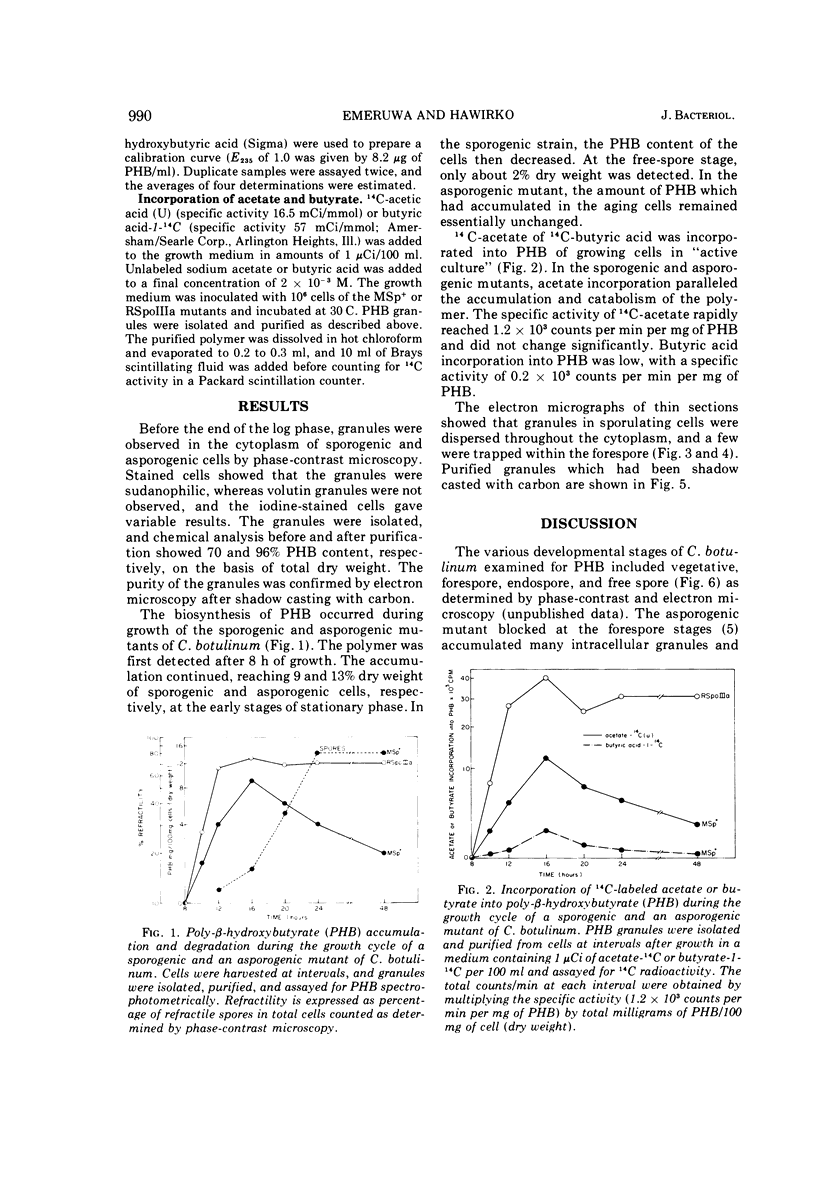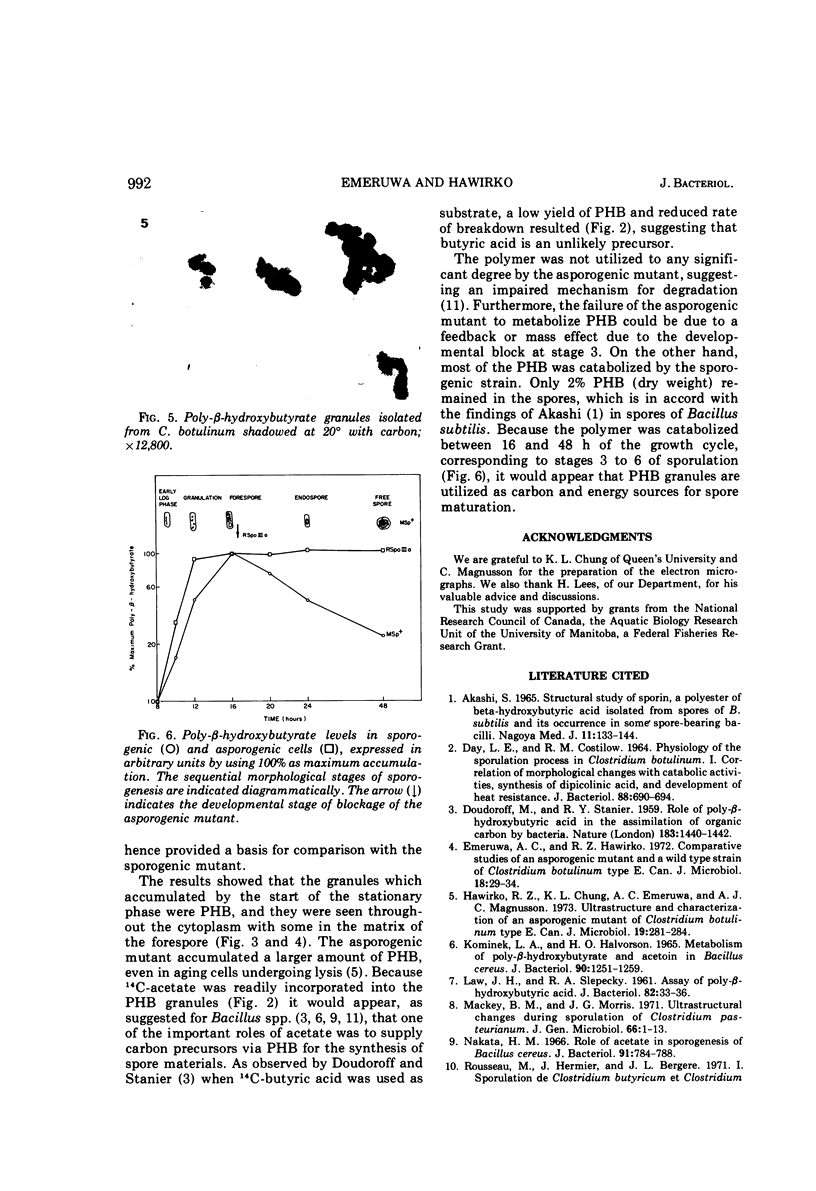Abstract
The granules observed in the cytoplasm of cells of sporogenic and asporogenic strains of Clostridium botulinum type E were isolated at various developmental stages of growth and sporulation. Electron microscopy of thin sections showed that most of the granules were dispersed throughout the cytoplasm. Chemical analysis and electron microscopy showed that the granules were poly-β-hydroxybutyrate (PHB). The polymer began to accumulate after 8 h of growth, reaching 9 and 13% of the cell dry weight in the sporogenic and asporogenic strains, respectively, during early stationary phase. 14C-acetate was readily incorporated into PHB. The rate of assimilation paralleled the production and utilization of PHB, indicating that the acetate served as its precursor. 14C-butyric acid was not utilized to any significant extent. Most of the PHB which had accumulated in the sporogenic strain was catabolized during the development of the spore, but in the asporogenic mutant it remained essentially unchanged. The findings suggest that the PHB provides endogenous carbon and energy for the synthesis of spore-specific components required for spore maturation.
Full text
PDF




Images in this article
Selected References
These references are in PubMed. This may not be the complete list of references from this article.
- Akashi S. Structural study of sporin, a polyester of beta-hydroxybutyric acid, isolated from spores of B, subtilis and its occurrence in some spore-bearing bacilli. Nagoya Med J. 1965 Dec;11(3):133–144. [PubMed] [Google Scholar]
- DAY L. E., COSTILOW R. N. PHYSIOLOGY OF THE SPORULATION PROCESS IN CLOSTRIDIUM BOTULINUM. I. CORRELATION OF MORPHOLOGICAL CHANGES WITH CATABOLIC ACTIVITIES, SYNTHESIS OF DIPICOLINIC ACID, AND DEVELOPMENT OF HEAT RESISTANCE. J Bacteriol. 1964 Sep;88:690–694. doi: 10.1128/jb.88.3.690-694.1964. [DOI] [PMC free article] [PubMed] [Google Scholar]
- DOUDOROFF M., STANIER R. Y. Role of poly-beta-hydroxybutyric acid in the assimilation of organic carbon by bacteria. Nature. 1959 May 23;183(4673):1440–1442. doi: 10.1038/1831440a0. [DOI] [PubMed] [Google Scholar]
- Emeruwa A. C., Hawirko R. Z. Comparative studies of an asporogenic mutant and a wild type strain of Clostridium botulinum type E 1 . Can J Microbiol. 1972 Jan;18(1):29–34. doi: 10.1139/m72-005. [DOI] [PubMed] [Google Scholar]
- Hawirko R. Z., Chung K. L., Emeruwa A. C., Magnusson A. J. Ultrastructure and characterization of an asporogenic mutant of Clostridium botulinum type E. Can J Microbiol. 1973 Feb;19(2):281–284. doi: 10.1139/m73-042. [DOI] [PubMed] [Google Scholar]
- Kominek L. A., Halvorson H. O. Metabolism of poly-beta-hydroxybutyrate and acetoin in Bacillus cereus. J Bacteriol. 1965 Nov;90(5):1251–1259. doi: 10.1128/jb.90.5.1251-1259.1965. [DOI] [PMC free article] [PubMed] [Google Scholar]
- LAW J. H., SLEPECKY R. A. Assay of poly-beta-hydroxybutyric acid. J Bacteriol. 1961 Jul;82:33–36. doi: 10.1128/jb.82.1.33-36.1961. [DOI] [PMC free article] [PubMed] [Google Scholar]
- Nakata H. M. Role of acetate in sporogenesis of Bacillus cereus. J Bacteriol. 1966 Feb;91(2):784–788. doi: 10.1128/jb.91.2.784-788.1966. [DOI] [PMC free article] [PubMed] [Google Scholar]
- Slepecky R. A., Law J. H. SYNTHESIS AND DEGRADATION OF POLY-beta-HYDROXYBUTYRIC ACID IN CONNECTION WITH SPORULATION OF BACILLUS MEGATERIUM. J Bacteriol. 1961 Jul;82(1):37–42. doi: 10.1128/jb.82.1.37-42.1961. [DOI] [PMC free article] [PubMed] [Google Scholar]
- Strasdine G. A. Amylopectin accumulation in Clostridium botulinum type E. Can J Microbiol. 1968 Oct;14(10):1059–1062. doi: 10.1139/m68-178. [DOI] [PubMed] [Google Scholar]
- WILLIAMSON D. H., WILKINSON J. F. The isolation and estimation of the poly-beta-hydroxybutyrate inclusions of Bacillus species. J Gen Microbiol. 1958 Aug;19(1):198–209. doi: 10.1099/00221287-19-1-198. [DOI] [PubMed] [Google Scholar]




